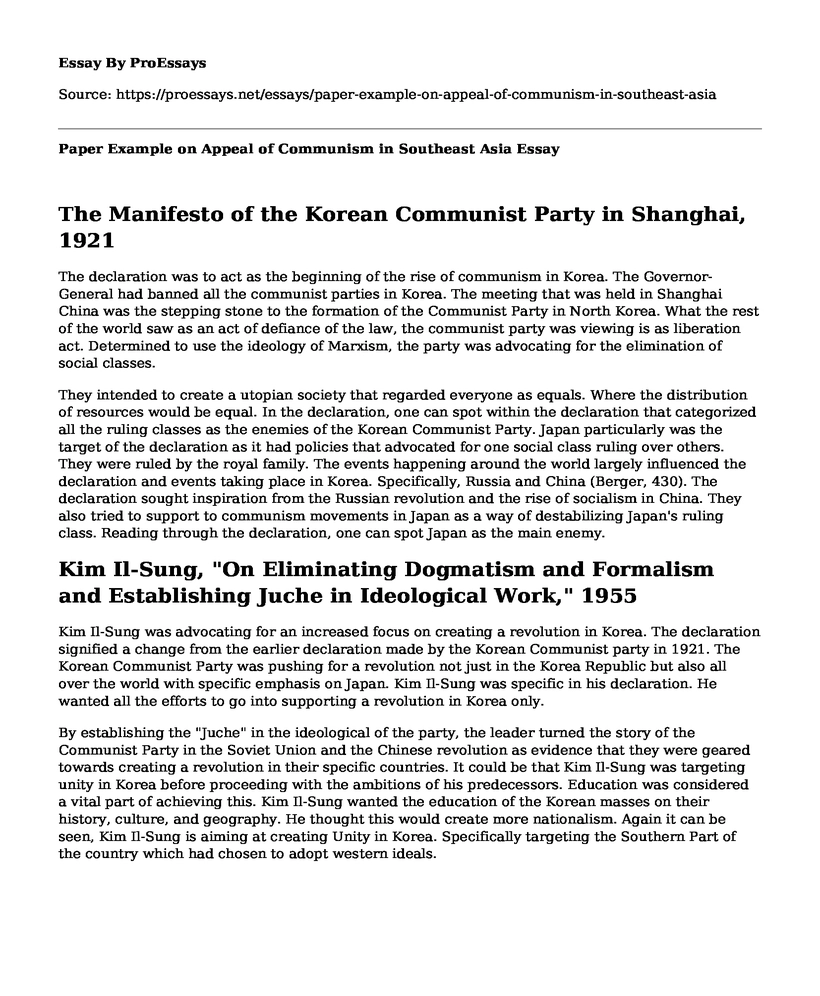The Manifesto of the Korean Communist Party in Shanghai, 1921
The declaration was to act as the beginning of the rise of communism in Korea. The Governor-General had banned all the communist parties in Korea. The meeting that was held in Shanghai China was the stepping stone to the formation of the Communist Party in North Korea. What the rest of the world saw as an act of defiance of the law, the communist party was viewing is as liberation act. Determined to use the ideology of Marxism, the party was advocating for the elimination of social classes.
They intended to create a utopian society that regarded everyone as equals. Where the distribution of resources would be equal. In the declaration, one can spot within the declaration that categorized all the ruling classes as the enemies of the Korean Communist Party. Japan particularly was the target of the declaration as it had policies that advocated for one social class ruling over others. They were ruled by the royal family. The events happening around the world largely influenced the declaration and events taking place in Korea. Specifically, Russia and China (Berger, 430). The declaration sought inspiration from the Russian revolution and the rise of socialism in China. They also tried to support to communism movements in Japan as a way of destabilizing Japan's ruling class. Reading through the declaration, one can spot Japan as the main enemy.
Kim Il-Sung, "On Eliminating Dogmatism and Formalism and Establishing Juche in Ideological Work," 1955
Kim Il-Sung was advocating for an increased focus on creating a revolution in Korea. The declaration signified a change from the earlier declaration made by the Korean Communist party in 1921. The Korean Communist Party was pushing for a revolution not just in the Korea Republic but also all over the world with specific emphasis on Japan. Kim Il-Sung was specific in his declaration. He wanted all the efforts to go into supporting a revolution in Korea only.
By establishing the "Juche" in the ideological of the party, the leader turned the story of the Communist Party in the Soviet Union and the Chinese revolution as evidence that they were geared towards creating a revolution in their specific countries. It could be that Kim Il-Sung was targeting unity in Korea before proceeding with the ambitions of his predecessors. Education was considered a vital part of achieving this. Kim Il-Sung wanted the education of the Korean masses on their history, culture, and geography. He thought this would create more nationalism. Again it can be seen, Kim Il-Sung is aiming at creating Unity in Korea. Specifically targeting the Southern Part of the country which had chosen to adopt western ideals.
East Asian Developmental States
The growth in South East Asia largely attributed to the development policies that were adopted by these countries (Yeung 342-350). In Japan for example, after the World War II, the large conglomerates that manufactured large industrial hardware were broken down into smaller companies. Their heads were also dismissed. Rather than slow down Japan's industrial might, these smaller companies grew to become giants in their own right hence increasing Japan's industrial production even more. Mitsubishi is an example of a company that underwent subdivision.
Up north, South Korea was quickly picking up the pace to become a member of what would be known as the Asian grand tigers. After the war, the government of South Korea adopted export-driven economic development policies. The then leader, Park Chung Hee focused his efforts on building industries that required intensive technological development. These included shipbuilding, steel, petrochemicals, steel, and electronics.
In China, something similar was taking place. The government had huge ownership of certain industries. The government's firm grip on the economy enabled them to dictate where resources would be redirected easily. This enabled the Chinese government to dedicate huge resources towards investment. The government particularly had a firm grip on the country's financial system. The banks were nationalized, unified the monetary system, and placed restrictions on government budgets. This guaranteed the value of the currency.
Work Cited
Yeung, Henry Wai-Chung. "Regional development and the competitive dynamics of global production networks: an East Asian perspective." Regional Studies 43.3 (2009): 325-351.
Berger, Mark T. "Decolonisation, modernization and nation-building: Political development theory and the appeal of communism in Southeast Asia, 1945-1975." Journal of Southeast Asian Studies 34.3 (2003): 421-448.
Cite this page
Paper Example on Appeal of Communism in Southeast Asia. (2022, May 22). Retrieved from https://proessays.net/essays/paper-example-on-appeal-of-communism-in-southeast-asia
If you are the original author of this essay and no longer wish to have it published on the ProEssays website, please click below to request its removal:
- It Is Expensive to Be Poor
- One Woman, One Vote Documentary Essay
- 1MDB Scandal Essay Example
- Article Analysis Essay on How Obama Failed Black Americans
- Essay Sample on Piscataway Municipality To Improve Access To Clean Energy: Bulk Purchases For Lower Rates
- Legislative Changes & Gideon J. Tucker: Navigating Legal Battles With Diligent Watchfulness - Essay Sample
- Paper Sample on 18th Century Worldwide Revolution: Technology, Economy, and Urban Planning







